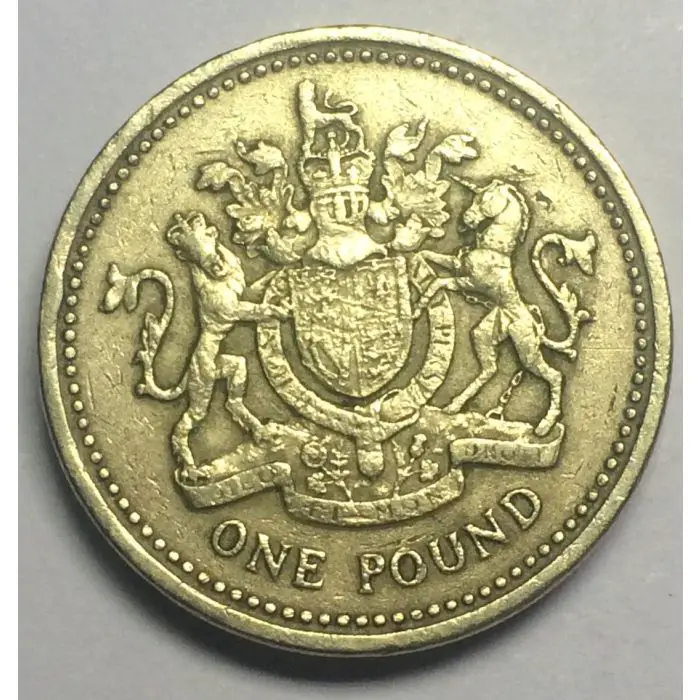The British pound coin has a rich history that dates back to its introduction in 1983. This significant event marked the replacement of the Bank of England’s one pound note with a new coin. Over the years, the design and features of the pound coin have evolved, making it an integral part of the UK’s currency system.
The Purpose of Issuing a Pound Coin
The need for a more durable and long-lasting form of currency primarily drove the decision to introduce a pound coin. The one pound note, which typically had a relatively short lifespan of approximately nine months, would often become damaged or defaced after repeated usage. In contrast, a pound coin could remain in circulation for 40 years or even longer.
On July 31, 1981, the UK government announced its intention to replace the one pound note with a new coin. This change aimed to improve the longevity and practicality of the currency, ensuring that it could withstand the demands of everyday use.
The Design of the Pound Coin
The obverse side of the pound coin features a Latin inscription that reads ‘Elizabeth II D G REG,’ which stands for “Dei Gratia Regina” or “Elizabeth II, by the Grace of God, Queen and Defender of the Faith.” Since its initial release in 1983, the pound coin has featured four different portraits of Queen Elizabeth II, each distinct from the others. The year of mintage is also engraved alongside the Latin inscription.
The reverse side of the pound coin has undergone regular changes since 1983 to represent England, Scotland, Wales, and Northern Ireland, the constituent countries of the United Kingdom. Each year, the coin showcases a different emblem representing one of these regions, along with the inscription ‘one pound.’
Evolution of the Pound Coin Design
Since its introduction in 1983, the pound coin has undergone several design changes. Arnold Machin designed the first series of coins, featuring a portrait of Queen Elizabeth II wearing a tiara. In 1985, Raphael Maklouf introduced a new portrait, depicting the Queen wearing the George IV State Diadem. This design remained in circulation until 1997.
From 1998 to 2015, Ian Rank-Broadley’s portrait, once again showing the Queen wearing a tiara, graced the pound coin. In 2015, Jody Clark, a renowned designer, was commissioned to create a new portrait of Queen Elizabeth II for the pound coin. This design showcases the Queen wearing the George IV State Diadem.
Introduction of the New Pound Coin in 2017
In 2017, a new 12-sided pound coin was introduced to replace the round pound coin. This bimetallic coin features a design that makes it more challenging to counterfeit. The new coin also includes a concealed security feature visible under ultraviolet light.
The design of the new pound coin was the result of a design competition held in 2014, in which members of the public participated. The winning design, created by a 15-year-old named David Pearce, features a rose, thistle, leek, and shamrock, encircled by a crown.
Counterfeit Coins and Security Measures
As the round pound coin gained popularity, counterfeiters attempted to replicate it. By 2013, an estimated 3.04% of the pound coins in circulation were counterfeit. The areas most affected by counterfeit coins were Northern Ireland, the South-East of England, and the City of London.
To combat counterfeiting, the Royal Mint commissioned coin testing companies to study the issue. They discovered that the actual number of counterfeit coins was approximately twice the Royal Mint’s initial estimate. Some counterfeit coins had poor quality and noticeable visual differences in design, while others were more sophisticated and required specialized detection machines.
The End of the Round Pound
The production of the round pound coins ceased in December 2015. The new 12-sided pound coin replaced it, featuring enhanced security features and a more durable design. The round pound coins minted by the British Crown dependencies and Gibraltar, while similar to the UK pound coin, were never legal tender in the UK.
To this day, the British pound coin remains an essential part of the UK’s currency system, symbolizing the country’s economic strength and stability.
Conclusion
The introduction of the British pound coin in 1983 marked a significant milestone in the history of UK currency. As a replacement for the one pound note, the pound coin offered enhanced durability and longevity. Over the years, the design of the pound coin has evolved, with different portraits of Queen Elizabeth II adorning the obverse side. The introduction of the new 12-sided pound coin in 2017 further improved security and made counterfeiting more difficult. The pound coin continues to be a vital component of the UK’s currency system, reflecting the country’s rich history and economic stability.

